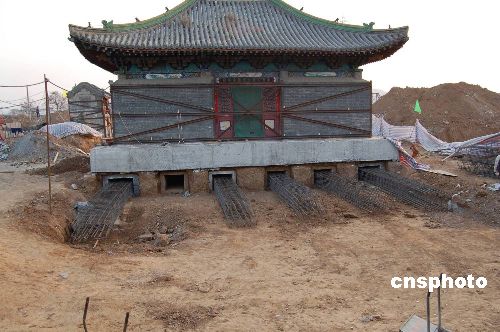

 |
| (Ciyuan Temple in Henan province was moved about 1,200 meters in 2006. Photo/China News Service) |
In 2001, the Jinlun Guild Assembly Hall in Guangzhou, Guangdong province was picked up whole and moved 80.4 meters from its original location, where it was built in the early 1700s.
In 2003, the Shanghai Concert Hall, built in 1930, was moved 68 meters to enable the construction of a new road.
In 2014, the Zhengguanghe Building in Wuzhou, Guangxi province was moved 38 meters from its original 1935 position to make room for new development.
These bold engineering undertakings have become increasingly common in China since the turn of the century, according to a recent CNN report, even spawning a specialized industry to carry out the moves. What’s more, the rest of the world is taking note, and everyone has an opinion.
Lan Wuji, the founder of Shanghai-based Evolution Shift, which specializes in building relocation, told CNN why he supports the relocation projects.
“Relocation has several benefits compared to demolition and rebuilding,” Lan explained. “It costs less, it provides a better conservation of the building, it’s more environmentally friendly and it saves time.” His firm was responsible for moving the former British embassy in Beijing and the old Agricultural and Industrial Bank of China building.
Others, however, are more ambivalent. In response to the 2002 relocation of Murray House, a historical Hong Kong structure originally built to house military officials in 1844, Professor Hoyin Lee of the University of Hong Kong pointed out that the context lost by moving the building was essential to the building’s true preservation. While it used to stand in Hong Kong’s financial district, the Murray House now resides in the waterfront neighborhood of Stanley, where it serves as shopping mall.
“Hundreds of years later, you’re going to have people wondering, ‘Why is this building here?’” Lee told CNN.
However, despite the various reservations and plaudits experts have offered, the Chinese public seems to be largely of one mind when it comes to building relocation. As a Global Times article points out, the majority of Chinese responses to the original CNN piece (titled “Should China move its historic monuments”) ask just one question: This is China’s business—what does it have to do with you?
Several netizens also mocked the article’s Western perspective in light of the current political situation in the United States. One commenter jokingly asked whether the U.S. might want to move the Great Wall to its own border with Mexico. Another wrote: “Moving buildings is nothing. America is packing up all the people it dislikes and moving them away…”
One thing is certain, the Global Times article concludes: China’s construction and engineering prowess will continue to captivate the world.
 Fire brigade in Shanghai holds group wedding
Fire brigade in Shanghai holds group wedding Tourists enjoy ice sculptures in Datan Town, north China
Tourists enjoy ice sculptures in Datan Town, north China Sunset scenery of Dayan Pagoda in Xi'an
Sunset scenery of Dayan Pagoda in Xi'an Tourists have fun at scenic spot in Nanlong Town, NW China
Tourists have fun at scenic spot in Nanlong Town, NW China Harbin attracts tourists by making best use of ice in winter
Harbin attracts tourists by making best use of ice in winter In pics: FIS Alpine Ski Women's World Cup Slalom
In pics: FIS Alpine Ski Women's World Cup Slalom Black-necked cranes rest at reservoir in Lhunzhub County, Lhasa
Black-necked cranes rest at reservoir in Lhunzhub County, Lhasa China's FAST telescope will be available to foreign scientists in April
China's FAST telescope will be available to foreign scientists in April "She power" plays indispensable role in poverty alleviation
"She power" plays indispensable role in poverty alleviation Top 10 world news events of People's Daily in 2020
Top 10 world news events of People's Daily in 2020 Top 10 China news events of People's Daily in 2020
Top 10 China news events of People's Daily in 2020 Top 10 media buzzwords of 2020
Top 10 media buzzwords of 2020 Year-ender:10 major tourism stories of 2020
Year-ender:10 major tourism stories of 2020 No interference in Venezuelan issues
No interference in Venezuelan issues
 Biz prepares for trade spat
Biz prepares for trade spat
 Broadcasting Continent
Broadcasting Continent Australia wins Chinese CEOs as US loses
Australia wins Chinese CEOs as US loses